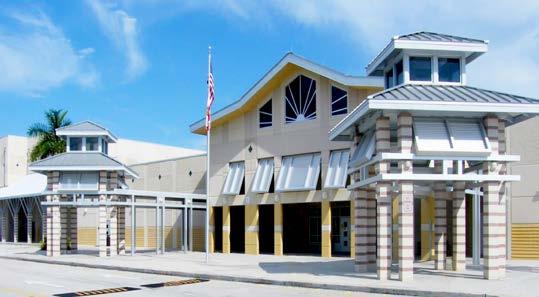
4 minute read
Shelter Locations
Evacuation centers should only be considered as a shelter of last resort. Not all shelters will be opened at the same time. Once an evacuation order has been issued, stay tuned to local TV and radio stations for shelter opening announcements. Check YOUR shelter information and locations and plan accordingly if you have pets (see Page 13 for pet safety/shelter information). • Evacuations orders are implemented in mobile home parks which are mandatory evacuation zones in the City of Greenacres. • If you have medical needs, and need a Special Needs Shelter, call 561-712-6400 to Pre-
Register or visit https://discover.pbcgov.org for an online application. • EMS Units transport pre-registered special needs citizens to critical care shelter.
John I. Leonard High School
4701 10th Avenue North Greenacres, FL 33463
Palm Beach Central High School
8499 Forest Hill Boulevard Wellington, FL 33411

Prepare a “go kit” with personal items you cannot do without during an emergency. If you evacuate, allow at least twice the usual travel time. Shut off water and gas to home. Take photo ID and proof of address. Unplug or turn breaker off to hot water heater.
Ensure the storm drain inlets in the roads and parking areas in your community are not clogged with a build-up of leaves or debris on the surface. During a storm, drains and catch basins can easily get clogged due to excess water and/ or debris, resulting in traffic impairments and other hazardous conditions. If you see that any drains on public roads are blocked, please contact the City’s Public Works Department at 561-642-2071.
ROADWAY SAFETY
GENERATOR SAFETY
Using a generator incorrectly can lead to dangerous situations. According to the Centers for Disease Control, over 500 people die each year from accidental Carbon Monoxide (CO) poisoning. Many of these deaths could have been avoided if the following safety guidelines were followed:
•NEVER use a portable generator indoors; only use a portable generator outside and away from any doors, windows, or vents that could allow CO to enter your home. They should
NOT be operated on the balcony of a multi-unit building. • Do not use a portable generator in the rain; consumer-grade generators are not weatherproof and there is a risk of electrocution or shock. • Follow the manufacturer’s instructions; plug appliances into heavy-duty extension cords and then plug the cords into the generator. • Purchase a carbon monoxide detector and ensure the unit is functioning correctly. • Never power the electric to the house wiring by plugging the generator into a wall outlet; this is called “back-feeding” and presents a serious risk to both utility workers and neighbors served by the same transformer. • Maintain an adequate supply of fuel and store in specifically approved containers in a cool, dry, ventilated and secure area, away from appliances. Keep out of the reach of children. • Turn generator off and let it cool before refuelling. 7
FOOD
Water, one (1) gallon of water per person per day for at least five (5) days, for drinking and sanitation. Mess kits, paper cups, plates, plastic utensils, and paper towels. Matches/lighter in a waterproof container. Can opener for food
(if kit contains canned food) Powdered drinks, instant coffee/tea
HOUSEHOLD ITEMS
Flashlight and extra batteries, sternos, lanterns. Whistle, to signal for help. Battery-powered radio (or hand crank radio), TV, fan and a NOAA Weather
Radio with tone alert and extra batteries for both. Wrench or pliers to turn off utilities. Fire extinguisher. Dust mask, or cotton t-shirt, to help filter contaminated air and plastic sheeting and duct tape to shelter-in-place. Emergency reference material such as a first aid book or information from www.ready.gov Local maps. Water purification tablets or household chlorine bleach and medicine dropper, for disinfecting, dilute nine parts water to one part bleach. In an extreme emergency for drinking purposes, you can use 16 drops of regular household bleach per gallon of water. Do not use scented, color safe or bleaches with added cleaners.

TOILETRIES
First Aid Kit, Face Masks
(include sunscreen, insect repellent) Personal hygiene items: • Soap, Sanitizer, Wipes • Toothbrush, toothpaste • Washcloths, towels, etc. • Shampoo, deodorant • Shaving kit • Feminine items Moist towelettes, garbage bags and plastic ties for personal sanitation. Sleeping bag or warm blanket for each person. Complete change of clothing including long sleeved shirt, long pants and sturdy shoes. Unique family needs, such as daily prescription medications, eye glasses, infant formula or diapers.
OTHER
Food, at least a five-day supply of nonperishable food: • Small containers of canned fruits, meats, vegetables and fish not requiring cooking • Crackers, dry cereal, granola bars, bread • Canned or bottled juices • Nuts, peanut butter • Dry Milk
Important family documents such as copies of insurance policies, identification and bank account records in a waterproof, portable container. Cash or traveler’s checks and change. Paper and pencil. Books, games, puzzles or other activities for children. It is recommended to have two (2) emergency kits - one full kit at home and a smaller portable kit in your vehicle.





